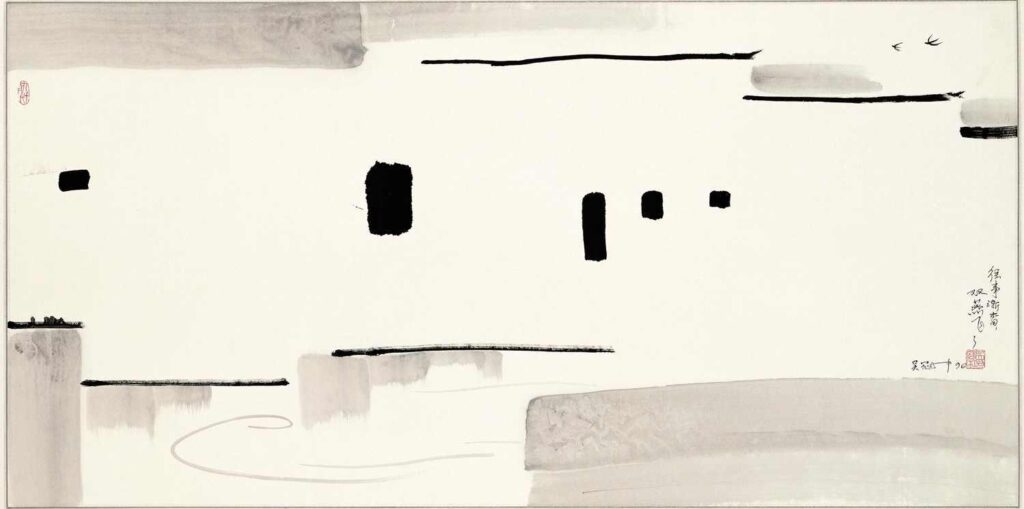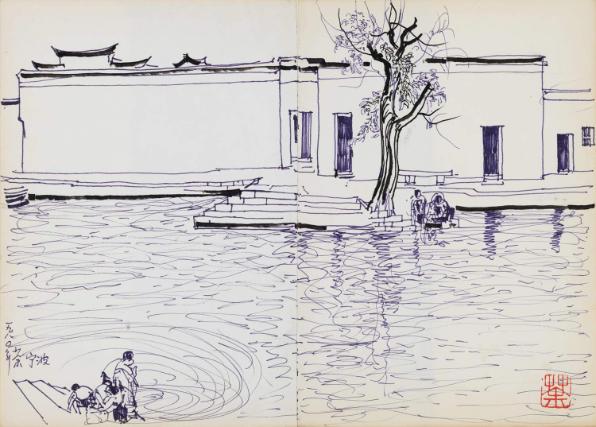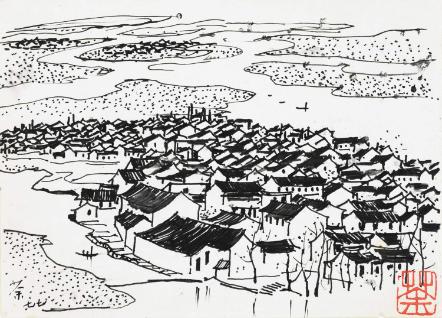Wu Guanzhong, a towering figure in modern Chinese artChinese art encompasses a vast array of forms and influences. It has a rich history that dates back over 5,000 years and is characterized by unique regional, philosophical, and political influences that have evolved over millennia. Ancient Era The origins of Chinese art trace back to prehistoric times, highlighted by significant archaeological discoveries. These findings include pottery, jade carvings, and More, seamlessly blended traditional Chinese techniques with Western styles. His works encapsulate the soul of Chinese landscapes and culture, while reflecting contemporary aesthetics.

Early Life and Education
Wu was born in 1919 in Yixing, Jiangsu province. His passion for art was evident from a young age. After attending the National Arts Academy of Hangzhou, he pursued further studies in Paris at the École Nationale Supérieure des Beaux-Arts.
- Birth: 1919, Yixing, Jiangsu province
- Education: National Arts Academy of Hangzhou, École Nationale Supérieure des Beaux-Arts in Paris

Influence of Western Art
During his time in Paris, Wu encountered works by Cézanne, Matisse, and Picasso. He absorbed elements of Post-ImpressionismPost-Impressionism is an art movement that emerged in France in the late 19th century, following the close of the Impressionist era. While it retained the vivid color palette and real-life subject matter of Impressionism, Post-Impressionism rejected its limitations by emphasizing a more structured, formal composition and greater emotional depth. This movement was not defined by a single aesthetic but represented More and FauvismThe Fauvism art movement applies to a group of modernist artists in the early 20th century including Henri Matisse and André Derain, who emphasized strong colour contrasts and painterly qualities with fierce brushwork over realistic values. Fauvism as a style started around 1904 and continued far beyond 1910. The group of Fauves however only worked together for the years between More, which profoundly impacted his artistic approach. These influences were evident in his use of color and form, blending traditional Chinese aesthetics with Western modernismThe term Modernism refers to a global movement in society and culture which sought the departure from traditional forms of thinking in favour of the creation of new forms of art, philosophy, and social organisation. Reflecting the transformations in western society during the late 19th and early 20th centuries and the newly emerging industrial world provided the impetus to depart More.
Key Influences
- Artists: Cézanne, Matisse, Picasso
- Styles: Post-ImpressionismPost-Impressionism is an art movement that emerged in France in the late 19th century, following the close of the Impressionist era. While it retained the vivid color palette and real-life subject matter of Impressionism, Post-Impressionism rejected its limitations by emphasizing a more structured, formal composition and greater emotional depth. This movement was not defined by a single aesthetic but represented More, FauvismThe Fauvism art movement applies to a group of modernist artists in the early 20th century including Henri Matisse and André Derain, who emphasized strong colour contrasts and painterly qualities with fierce brushwork over realistic values. Fauvism as a style started around 1904 and continued far beyond 1910. The group of Fauves however only worked together for the years between More

Return to China
Upon returning to China in 1950, Wu began teaching at various art institutions. He integrated Western techniques into his traditional Chinese training, evolving his unique style. This marked a significant departure from conventional Chinese paintingPainting is a fundamental form of visual art that has been practiced for thousands of years. It involves applying pigment to a surface such as canvas, paper, or a wall. Painting can be explored through various styles, techniques, and mediums, each offering unique possibilities for expression and creativity. Historical Background • Ancient Beginnings: The history of painting dates back to More, making his work stand out in the art world.
Career Highlights
- Teaching: Various art institutions in China
- Integration: Western techniques with traditional Chinese artChinese art encompasses a vast array of forms and influences. It has a rich history that dates back over 5,000 years and is characterized by unique regional, philosophical, and political influences that have evolved over millennia. Ancient Era The origins of Chinese art trace back to prehistoric times, highlighted by significant archaeological discoveries. These findings include pottery, jade carvings, and More

Style and Technique
Wu’s works are known for their bold use of color, abstract forms, and calligraphic lines. He often abstracted natural forms, focusing on their essence rather than literal representation. His brushworkMasterful brushwork is often the defining feature of great artists, where the brush becomes an extension of their arm, allowing paint to flow effortlessly onto the canvas. These artists demonstrate a profound understanding of their medium, knowing precisely when to apply thick, textured strokes or smooth, delicate ones. Their skill extends beyond mere color application; it's about the artistry of More drew from Chinese calligraphyCalligraphy, the art of beautiful writing, has been practiced for centuries across various cultures. This artistic form of writing emphasizes the aesthetic presentation of letters and symbols, combining skillful penmanship with artistic expression. Historical Overview • Origins: Ancient civilizations such as China, Egypt, and Rome • Chinese Calligraphy: Developed around 2000 BC, using brush and ink • Islamic Calligraphy: Flourished More, lending a rhythmic quality to his compositions.
- Color: Vibrant and bold
- Forms: Abstract, focusing on essence
- Lines: Inspired by Chinese calligraphyCalligraphy, the art of beautiful writing, has been practiced for centuries across various cultures. This artistic form of writing emphasizes the aesthetic presentation of letters and symbols, combining skillful penmanship with artistic expression. Historical Overview • Origins: Ancient civilizations such as China, Egypt, and Rome • Chinese Calligraphy: Developed around 2000 BC, using brush and ink • Islamic Calligraphy: Flourished More

Major Works
Some of Wu’s most renowned pieces include “Hometown of Lu Xun,” which blends traditional Chinese landscapes with modern abstract forms, and “The Great Wall,” depicting the monumental structure with a contemporary twist. “Water Town in Jiangnan” combines delicate inkInk, a liquid or paste used for writing, drawing, and printing, has played a crucial role in communication and artistic expression throughout history. Made from various pigments and dyes, ink allows for the transfer of text and images onto surfaces such as paper, fabric, and other materials. Types of Ink There are several types of ink, each serving different purposes More work with bold, colorful elements.
Notable Pieces
- “Hometown of Lu Xun”: Traditional landscapes with modern abstraction
- “The Great Wall”: Contemporary depiction of the Great Wall
- “Water Town in Jiangnan”: Mix of delicate inkInk, a liquid or paste used for writing, drawing, and printing, has played a crucial role in communication and artistic expression throughout history. Made from various pigments and dyes, ink allows for the transfer of text and images onto surfaces such as paper, fabric, and other materials. Types of Ink There are several types of ink, each serving different purposes More and bold colors

Recognition and Legacy
Wu’s contributions to art earned him numerous accolades, including the Chevalier de L’Ordre des Arts et des Lettres from the French government in 1992. His works are housed in major museums worldwide, including the British Museum and the Metropolitan Museum of Art.
- Awards: Chevalier de L’Ordre des Arts et des Lettres (1992)
- Collections: British Museum, Metropolitan Museum of Art
Personal Philosophy
Wu believed that art should reflect personal experience and emotion. He advocated for the blending of cultures to enrich artistic expression and saw creativity as thriving on breaking traditional boundaries.

Core Beliefs
- Reflection: Art as personal experience
- Cultural Blend: Enriching artistic expression
- Innovation: Breaking traditional boundaries
Teaching and Influence
As an educator, Wu inspired countless students to explore beyond conventional styles. He emphasized the importance of personal expression in art and bridged the gap between Eastern and Western art traditions.
- Inspiration: Encouraged exploration beyond conventions
- Emphasis: Personal expression
- Legacy: Bridging Eastern and Western art

Later Years and Death
In his later years, Wu continued to produce groundbreaking work despite political and social challenges. He remained active in the art community, mentoring young artists until his passing in 2010. His legacy continues to inspire.
- Activity: Continued work and mentoring
- Death: 2010
Conclusion
Wu Guanzhong’s fusion of Eastern and Western art traditions has left a lasting impact on the world of modern art. His innovative approach and dedication to artistic freedom resonate in the works of artists worldwide. His legacy serves as a testament to the power of cultural synthesis and the enduring impact of creative vision.
You might enjoy reading further articles on Asian art by Pigment Pool:
Bamboo Art: Picture Serenity through Chinese Brushwork
Yin-Yang Aesthetic: A Symbol Transcending Time and Culture
Mandala Therapy: Art Techniques to Soothe Anxiety and Stress
Exploring Chinese Art: Tiger Symbolism, Styles, and Inspirations
Free Chinese Art Tiger Coloring Pages: Download for Art Enthusiasts
A brief history of colour pigments
Impressionism and Japonisme: How Japan Has Inspired Western Artists
